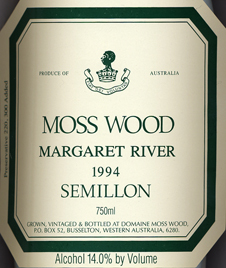Moss Wood 1994 Semillon

Wine Facts
| Harvested: | 09/3/1994 |
| Bottled: | 29/7/1994 |
| Released: | 11/10/1994 |
| Baume: | 12.90 |
| Alcohol: | 14.00% |
| Vintage Rating: | 9/10 |
SOLD OUT
Tasting Notes
The 1994 Moss Wood Semillon is similar in style to the 1993, it is riper and rounder but is less fragrant and less delicate than that wine. On the nose, the 1994 Semillon has perfumed, ripe fig and quince characters, is lightly herbaceous showing more grapefruit than gooseberries and lifted citrus flavours on the mid-palate with soft, ripe tannins on the finish.
The wine is a little out of the ordinary for the Moss Wood Semillon coming from one of the ripest vintages ever. In style, it is similar to the great 1983 which is perhaps riper and rounder, all figs and honey, while the 1994 Semillon is more delicate and fragrant with grassy, citrus characters, it has medium weight, full body, good depth of flavour and lively, persistent flavours. We recommend the wine with enthusiasm.
Vintage Notes
The 1994 vintage is the second consecutive year in which Moss Wood has not produced a wood matured semillon. While the reason for not making the wooded wine in 1993 was the shortage of fruit caused by November storms, we have decided to use all of the semillon this year to make an unwooded wine believing that there is currently a consumer preference for fresher, fruitier styles and increased interest in the traditional Australian unwooded semillon.
We believe that the oak influence has overridden seasonal variations in the wood matured semillon and that there is consumer interest in such vintage variation. Consequently, we have decided to concentrate on production of the unwooded semillon which we believe to be the traditional Australian style, which developed first in the Hunter Valley. If there is a massive backlash from consumers, we will be happy to re-assess the position.
Production Notes
The 1994 Semillon was produced by the usual method followed at Moss Wood. The grapes were crushed, drained and pressed and all pressings were included immediately in the juice. This was chilled, settled for forty eight hours, then racked, seeded with a pure yeast culture and fermented at 18�C to dryness. At that stage, it is treated with sulphur dioxide and left on lees for two months with weekly stirring under carbon dioxide. The wine was then fined, filtered and bottled.
Cellaring Notes
It is one of the best ever cellaring prospects and will improve over the next decade or more with careful storage

